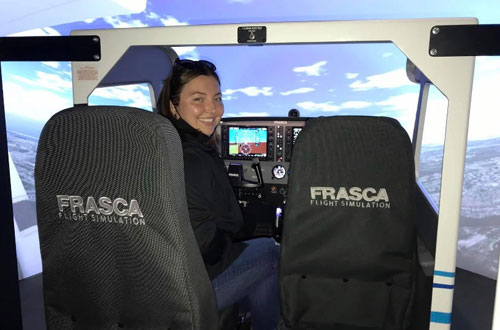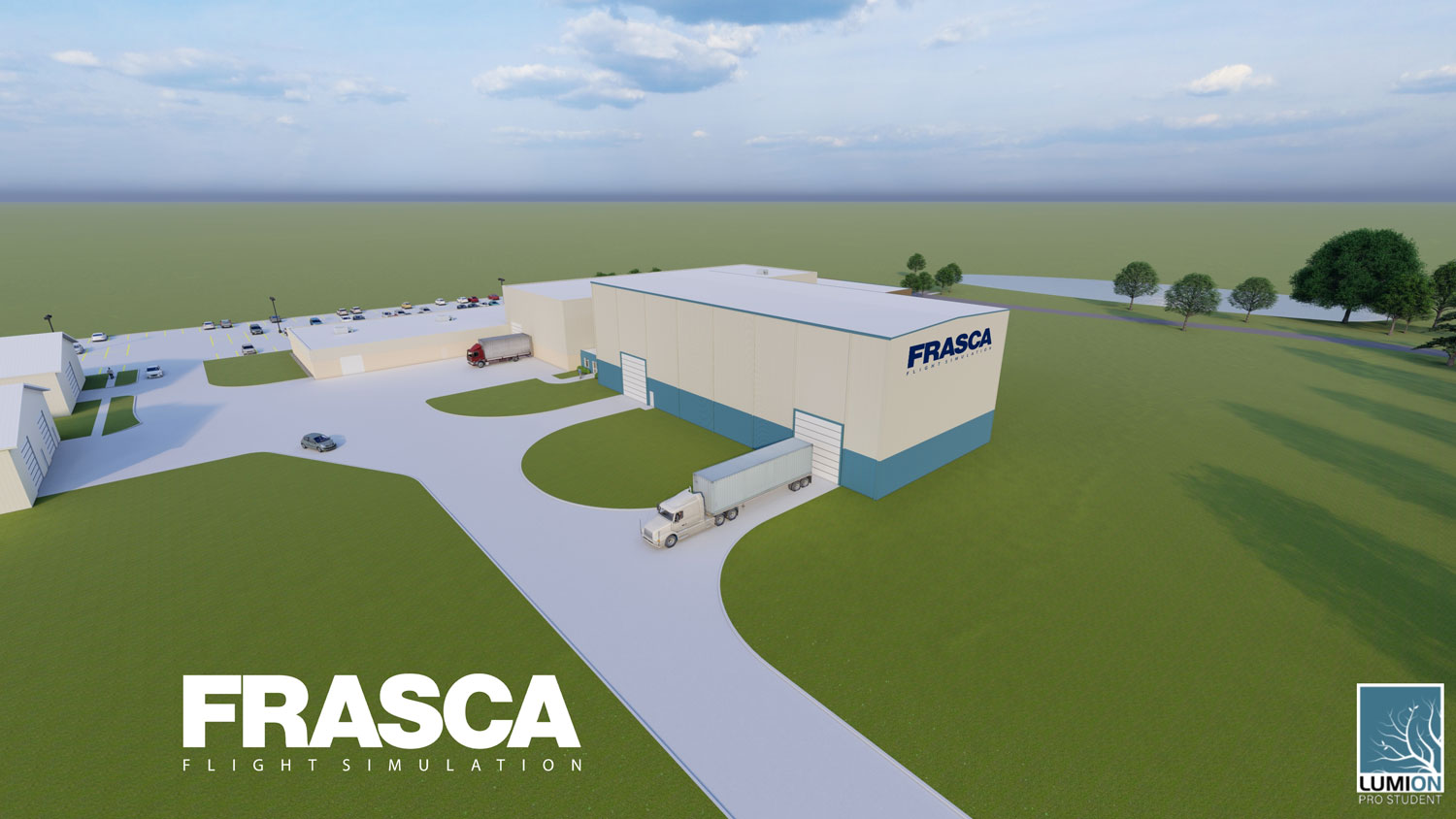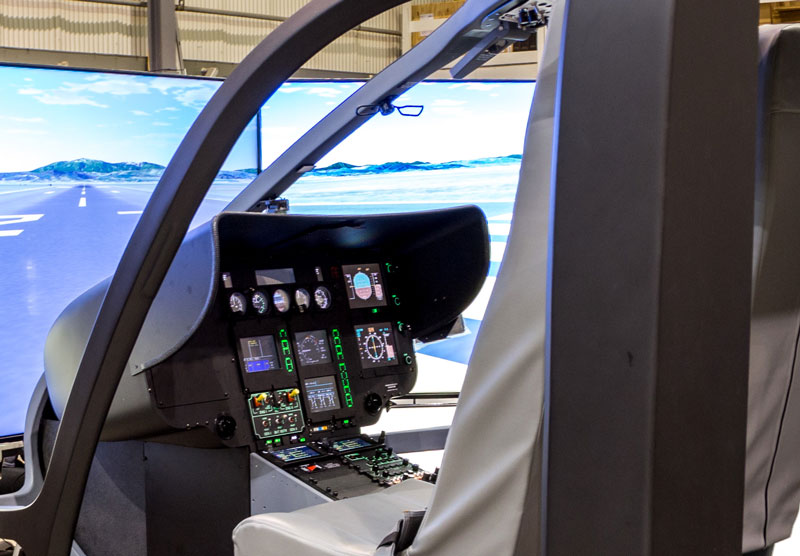Haley Konfrst, an IR student at Epic Flight Academy, experiencing Epic’s newest simulator, a FRASCA Cessna 172 Advanced Aviation Training Device (AATD) with FRASCA’s Motion Cueing System for fixed-wing devices (FMCS-FX)
FRASCA spoke with Dr. Cindy Lovell, Director of Education at Epic Flight Academy, about the flight school’s growing fleet of FRASCA Advanced Aviation Training Devices (AATD). Epic recently became the first flight school in the world to take delivery of a FRASCA Cessna 172 AATD with FRASCA’s Motion Cueing System for fixed-wing devices (FMCS-FX). https://epicflightacademy.com/
Q&A:
How many students are enrolled in the program?
CL: We have 195 flight students enrolled at this time.
What do you have in your aircraft fleet?
CL: We currently have 15 Cessna 172S G1000 NXi and 3 Piper PA-44 Seminoles. We also have a vintage American Airlines DC-7 displayed on campus, but obviously it’s not part of our flying fleet. We get a lot of visitors who come by to check it out. It’s become something of a tourist attraction.
Tell us about your current and upcoming simulator fleet:
CL: Our simulator fleet includes a FRASCA Truflite Cessna 172 with 180-degree visual system, full enclosure cockpit, G1000 cockpit; a FRASCA Truflite PA-44 multi-engine sim, full enclosure, one large screen for visuals; a Precision Flight Control GTX Max Cessna Trainer, Partial Motion Platform, G1000 Cockpit; a FRASCA Mentor Cessna 172 sim, which is a smaller unit mainly used for instrument training, G1000 cockpit; and our latest and greatest acquisition, a FRASCA Cessna 172 Advanced Aviation Training Device (AATD) with FRASCA’s Motion Cueing System for fixed-wing devices (FMCS-FX). We are the first flight school in the world to have this one. It includes a high-fidelity, six-axis motion system along with an extremely realistic, wrap-around visual system. We just took delivery, and the students are already loving it.
How do you integrate your simulators into your program?
CL: All courses include flight simulation. Our motto is “Safety first!” and simulators are essential in providing opportunities for our students to experience a multitude of emergency scenarios in a safe environment. PPL students can safely experience simulated engine failures, avionics failures, fuel failures, etc. in a perfectly safe environment. Likewise, simulators augment our instrument training. IR students can safely experience the effects of zero visibility under various emergency scenarios. AATDs have revolutionized training at every level, and our students learn to navigate under IFR while coping with simulated emergencies. Once they are proficient in the simulator, they can apply these skills in the aircraft.
What features are most important to you in a simulator?
CL: Students want the simulator to feel like they’re flying an actual aircraft, so realism is important. It’s also important that our simulators mirror our actual aircraft. The visuals must be high-definition so the terrain appears to be real to our students. Certainly, user-friendly controls for instructors are important, and our equipment has to be reliable with excellent service and support from the manufacturer. We worked very closely with FRASCA to develop our newest simulator, and we couldn’t be happier with the realistic aspect and the high level of motion system. The ultimate goal is for students to feel like they are flying an actual aircraft.
What features do you like most about your FRASCA devices?
CL: The G1000 NXi cockpit is essential and something that really supports our students. Right now, everyone on campus is smitten with the six-axis Motion Cueing System for fixed-wing devices (FMCS-FX) in our newest simulator. The wrap-around visual system is incredibly realistic.
What do your students and instructors have to say about learning in the FRASCA sims?
CL: Haley Konfrst, pictured, is currently earning her instrument rating. Haley said, “I really enjoyed how immersive and realistic the new FRASCA flight simulator felt. With every turn, climb, and descent, I could feel the sim moving, and it added to the entire experience. I can absolutely see how this full-motion simulator will improve simulation training for new pilots who are still learning new skills and maneuvers. Together, FRASCA and Epic have really raised the bar of flight training for the rest of the world!” Ray Altmann, who completed his PPL, IR, and CSEL at Epic, also commented on the newest simulator, adding, “The simulator’s cockpit is the closest I’ve seen to the actual Cessna 172 aircraft that Epic Flight Academy uses. After a few minutes, you forget you are still on the ground due to the realistic graphics, feelings, and performance of the simulator. It is also very user-friendly for the instructor due to the fact that they can use their own tablet, while sitting next to their students in the cockpit to change aircraft position, weather, and simulated malfunctions. The full-motion simulator will be a huge benefit to students because they can actually rehearse all of their maneuvers and procedures while on the ground, yet feel like they are in the plane. This will lead to a quick translation of the skills and more proficient students overall.” Epic instructors agree that no flight school should rely solely on aircraft when simulators provide these types of experiences. Captain Judy Rice added, “As Epic Flight Academy private pilot ground instructor, students and instructors are reporting the powerful, new learning tool the FRASCA sims adds to our learning environment. Instructors have the ability to experience realistic flight maneuvers, pausing and replaying for the greatest learning opportunity. In addition, the motion and images are impressive beyond description.” Josh Schwenn, Director of Flight Operations, also weighed in, saying “Our newest FRASCA simulator provides the opportunity for our students to not only experience high quality environmental graphics for true to life VFR navigation, but to also safely feel how the aircraft responds to control inputs in various flight conditions. This is all thanks to a one-of-a-kind motion queuing system. Paired with a scale replica of the 172 NAV III cockpit and next generation operating software, this device brings ultra-realistic flight training to a whole new level.”
What was the decision process to adding a motion base to your FRASCA device?
CL: Epic has been training pilots since 1999, and with the emphasis always on safety, we have constantly looked for the most effective ways to ensure the safety of our students and instructors. We knew that adding the motion base would elevate the experience of realism and help students develop the skills and confidence needed in the cockpit. This was a no-brainer, and we were thrilled that FRASCA was willing to work with us to create something brand new. Although we’re the first flight school in the world to offer this, I doubt we’ll be the last. Our students and instructors are already experiencing the benefits.
How will the Motion System enhance flight training for your students?
CL: You may get tired of hearing this, but safety really does come first here at Epic, and that’s the main enhancement for us. The ability to practice emergency maneuvers in a full-motion AATD like this elevates our students’ skillset. Of course, simulators benefit our students in other ways, such as saving them time and money. When it’s too windy to fly or a thunderstorm has grounded flights, students can continue their training in a simulator. It is also more cost effective for students. Simulators don’t need fuel and are far less costly to maintain than our aircraft fleet. So, the combination of training with enhanced safety while saving time and money makes our students very happy.




